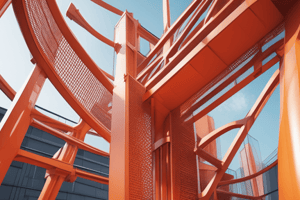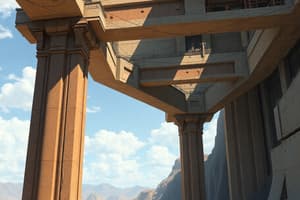Podcast
Questions and Answers
What does the term 'Ay' refer to in the context of column notations?
What does the term 'Ay' refer to in the context of column notations?
- Effective flexural stiffness of the member
- Factored end moment on a compression member
- Area of the gross section of column (correct)
- Moment of inertia of the gross section of column
Which parameter is NOT related to the effective length of a column?
Which parameter is NOT related to the effective length of a column?
- Factored end moment due to sidesway
- Factored moment used for design of columns (correct)
- Effective length factor
- Unsupported length of the member
What is the unit of measurement for the effective flexural stiffness of a member?
What is the unit of measurement for the effective flexural stiffness of a member?
- Nmm⁴ (correct)
- mm
- N/mm²
- kNm
In the context of column behavior, what does a factored end moment calculated due to appreciable sidesway indicate?
In the context of column behavior, what does a factored end moment calculated due to appreciable sidesway indicate?
Which of the following factors is crucial for determining the moment of inertia of a column?
Which of the following factors is crucial for determining the moment of inertia of a column?
Under what condition can torsional effects be neglected according to NSCP 2015?
Under what condition can torsional effects be neglected according to NSCP 2015?
What section provides the threshold torsion T;,, for structural members?
What section provides the threshold torsion T;,, for structural members?
What is required for a member to withstand cracking torsion T,,?
What is required for a member to withstand cracking torsion T,,?
What factor is used as a modification for normal weight concrete in the threshold torsion equations?
What factor is used as a modification for normal weight concrete in the threshold torsion equations?
How is the threshold torsion T,, calculated for a prestressed member?
How is the threshold torsion T,, calculated for a prestressed member?
What does the symbol N,, represent in the context of cracking torsion calculations?
What does the symbol N,, represent in the context of cracking torsion calculations?
Which type of cross-section is mentioned in the context of calculating cracking torsion?
Which type of cross-section is mentioned in the context of calculating cracking torsion?
In which scenario must a member be designed to resist torsional moments?
In which scenario must a member be designed to resist torsional moments?
What is the minimum clear spacing when using a double layer of bars, given that it meets the required criteria?
What is the minimum clear spacing when using a double layer of bars, given that it meets the required criteria?
What is the formula used to calculate the clear spacing between longitudinal bars?
What is the formula used to calculate the clear spacing between longitudinal bars?
What is a primary characteristic of a reinforced concrete column?
What is a primary characteristic of a reinforced concrete column?
In a single layer scenario, which of the following conditions rendered the spacing unacceptable?
In a single layer scenario, which of the following conditions rendered the spacing unacceptable?
Which symbol corresponds to the depth of the equivalent stress block in beam analysis?
Which symbol corresponds to the depth of the equivalent stress block in beam analysis?
Which type of column is characterized by longitudinal bars enclosed in a helix?
Which type of column is characterized by longitudinal bars enclosed in a helix?
What is the maximum height for a plain concrete pedestal based on its least lateral dimension?
What is the maximum height for a plain concrete pedestal based on its least lateral dimension?
What does the symbol 'C' represent in the context of beam analysis?
What does the symbol 'C' represent in the context of beam analysis?
What defines a composite column?
What defines a composite column?
What is the distance from the extreme compression fiber to the centroid of the tension reinforcement denoted by?
What is the distance from the extreme compression fiber to the centroid of the tension reinforcement denoted by?
Which value should be used for the maximum spacing if the diameter of the bar is 16 mm?
Which value should be used for the maximum spacing if the diameter of the bar is 16 mm?
Which of the following is NOT a reason for classifying columns?
Which of the following is NOT a reason for classifying columns?
What is the purpose of lateral ties in a tied column?
What is the purpose of lateral ties in a tied column?
What is the primary purpose of determining the spacing of longitudinal bars?
What is the primary purpose of determining the spacing of longitudinal bars?
What is meant by the diameter of equivalent bar in reinforced concrete?
What is meant by the diameter of equivalent bar in reinforced concrete?
How are reinforced concrete columns generally referred to?
How are reinforced concrete columns generally referred to?
Which section defines the spacing and cover values in relation to the equivalent diameter?
Which section defines the spacing and cover values in relation to the equivalent diameter?
What is a significant feature of a tied column compared to a spiral column?
What is a significant feature of a tied column compared to a spiral column?
What is the minimum specified concrete cover for slabs and joists according to the provided data?
What is the minimum specified concrete cover for slabs and joists according to the provided data?
What is the stated concrete cover requirement for reinforcement permanently in contact with the ground?
What is the stated concrete cover requirement for reinforcement permanently in contact with the ground?
For non-prestressed cast-in-place concrete members, where can the specified concrete cover requirements be found?
For non-prestressed cast-in-place concrete members, where can the specified concrete cover requirements be found?
Which factor is related to confinement terms in reinforced concrete?
Which factor is related to confinement terms in reinforced concrete?
What type of bars require at least a specified cover of 40 mm according to the guidelines?
What type of bars require at least a specified cover of 40 mm according to the guidelines?
What is the purpose of the specified concrete cover in construction?
What is the purpose of the specified concrete cover in construction?
Which formula represents the condition for torsion T, for non-prestressed and prestressed members?
Which formula represents the condition for torsion T, for non-prestressed and prestressed members?
What is the minimum angle A in the formulas given for T, determination?
What is the minimum angle A in the formulas given for T, determination?
For non-prestressed members subjected to axial force, what is the formula for T,?
For non-prestressed members subjected to axial force, what is the formula for T,?
What must be the maximum angle A according to the provided content?
What must be the maximum angle A according to the provided content?
Which of the following areas is specified as being determined by analysis for torsion calculations?
Which of the following areas is specified as being determined by analysis for torsion calculations?
In the formulas T, = 2A,A / Sy and T, = 2A,A / (P, cot@), what does P, represent?
In the formulas T, = 2A,A / Sy and T, = 2A,A / (P, cot@), what does P, represent?
For prestressed members, how is T, calculated based on area A, given the adjustable parameter?
For prestressed members, how is T, calculated based on area A, given the adjustable parameter?
What is the permissible value for area A in the equations according to the content?
What is the permissible value for area A in the equations according to the content?
Flashcards
Equivalent bar diameter
Equivalent bar diameter
The diameter used to calculate spacing and cover requirements for bundled bars.
Spacing limitations
Spacing limitations
Rules that control the minimum distance between reinforcing bars.
Cover requirements
Cover requirements
Minimum concrete distance from reinforcement to the surface of a structure.
Specified concrete cover (NSCP 2015)
Specified concrete cover (NSCP 2015)
Signup and view all the flashcards
Reinforcement
Reinforcement
Signup and view all the flashcards
Cast-in-place concrete
Cast-in-place concrete
Signup and view all the flashcards
Non-prestressed concrete
Non-prestressed concrete
Signup and view all the flashcards
Bundled bars
Bundled bars
Signup and view all the flashcards
Clear Spacing (S)
Clear Spacing (S)
Signup and view all the flashcards
Longitudinal Bars
Longitudinal Bars
Signup and view all the flashcards
NSCP 2015 Section 425.2.1
NSCP 2015 Section 425.2.1
Signup and view all the flashcards
Depth of Equivalent Stress Block (a)
Depth of Equivalent Stress Block (a)
Signup and view all the flashcards
Area of Tension Reinforcement (At)
Area of Tension Reinforcement (At)
Signup and view all the flashcards
Width of Compression Face (b)
Width of Compression Face (b)
Signup and view all the flashcards
Distance from extreme compression fiber to neutral axis(c)
Distance from extreme compression fiber to neutral axis(c)
Signup and view all the flashcards
Threshold Torsion (Tth)
Threshold Torsion (Tth)
Signup and view all the flashcards
Torsion in structural members
Torsion in structural members
Signup and view all the flashcards
Table 422.7.4.1
Table 422.7.4.1
Signup and view all the flashcards
Cracking Torsion (Tc)
Cracking Torsion (Tc)
Signup and view all the flashcards
Solid cross-section
Solid cross-section
Signup and view all the flashcards
Hollow cross-section
Hollow cross-section
Signup and view all the flashcards
Prestressed member
Prestressed member
Signup and view all the flashcards
Torsional Resistance
Torsional Resistance
Signup and view all the flashcards
Torsional Reinforcement
Torsional Reinforcement
Signup and view all the flashcards
Closed Stirrup
Closed Stirrup
Signup and view all the flashcards
Torsional Strength (T)
Torsional Strength (T)
Signup and view all the flashcards
Torsional Cracking
Torsional Cracking
Signup and view all the flashcards
Torsional Shear Stress (A)
Torsional Shear Stress (A)
Signup and view all the flashcards
Torsional Reinforcement Area
Torsional Reinforcement Area
Signup and view all the flashcards
Compression Member
Compression Member
Signup and view all the flashcards
Tied Columns
Tied Columns
Signup and view all the flashcards
Spiral Columns
Spiral Columns
Signup and view all the flashcards
Composite Columns
Composite Columns
Signup and view all the flashcards
Plain Concrete Pedestal
Plain Concrete Pedestal
Signup and view all the flashcards
Nominal Balanced Moment Capacity (Mon)
Nominal Balanced Moment Capacity (Mon)
Signup and view all the flashcards
Nominal Axial Compressive Strength (Pn)
Nominal Axial Compressive Strength (Pn)
Signup and view all the flashcards
Ultimate Moment Capacity (Mu)
Ultimate Moment Capacity (Mu)
Signup and view all the flashcards
Effective Length Factor (k)
Effective Length Factor (k)
Signup and view all the flashcards
Unsupported Length (L)
Unsupported Length (L)
Signup and view all the flashcards
Factored Moment (Mu)
Factored Moment (Mu)
Signup and view all the flashcards
Smaller End Moment (Ms)
Smaller End Moment (Ms)
Signup and view all the flashcards
Larger End Moment (Ml)
Larger End Moment (Ml)
Signup and view all the flashcards
Study Notes
Introduction to Reinforced Concrete
- Concrete is a mixture of aggregates (gravel, crushed rock, or sand) and a cement-water paste.
- Reinforced concrete combines concrete's compressive strength with steel's tensile strength.
Notations & Symbols
- Dead Load (D): Load due to the weight of the structure itself.
- Live Load (L): Load due to occupancy, movable objects, and the like.
- Wind Load (W): Load due to wind pressure.
- Earthquake Load (E): Load due to earthquake ground motion.
- Area of Bar (A): Cross-sectional area of reinforcing steel bars.
- Diameter of Bar (d, D): Diameter of the steel bar.
- Diameter of Aggregates (dagg): Diameter of the aggregates.
- Diameter of Stirrups (ds): Diameter of the stirrups.
- Modulus of Elasticity (E): Measures a material's stiffness.
- Specified Compressive Stress (fc): Maximum stress concrete can withstand under compression.
- Specified Yield Strength (fy): Stress at which steel starts to deform plastically.
- Eccentricity (e): Distance from the center of the load to the centroid of the column's cross section.
Concrete & Reinforced Concrete Components
- Concrete is a composite material, primarily consisting of aggregates, water, and cement.
- Steel reinforcement is used to enhance concrete's tensile capacity and ductility.
- Aggregates make up most of the concrete volume. Fine aggregates (typically sand) and coarse aggregates (typically gravel or crushed stone) are used.
Advantages of Reinforced Concrete
- High compressive strength
- Excellent resistance to fire and water damage
- Long service life without loss of performance (under proper conditions)
- Cost-effectiveness
- Castable into any shape
Disadvantages of Reinforced Concrete
- Low tensile strength necessitates reinforcement
- Forms and shoring required for cast-in-place construction
- Relatively low strength-to-weight ratio
- Properties can vary due to variations in its mixing
- Requires more maintenance than other materials
Design Codes and Specifications
- The National Structural Code of the Philippines (NSCP 2015) regulates the design and construction of buildings in the Philippines.
- ACI 318M-14 is a recognized standard for structural concrete.
- NSCP 2015 and ACI 318M-14 provide design requirements, considerations, and minimum criteria for structural members.
- Codes provide general guidelines for design.
Concrete Design Properties (NSCP 2015)
- Specified Compressive Strength (fc): Must be specified by construction documents.
- Modulus of Elasticity (Ec): Calculated based on concrete strength and weight and is affected by concrete age and type of loading.
Minimum Spacing of Reinforcement (NSCP 2015)
- Clear spacing between parallel reinforcement in a horizontal layer shall be at least 25mm, the largest of the bar diameter, and (4/3) times the diameter of aggregates.
Bundled Reinforcement (NSCP 2015)
- Bundled bars (limited to 4) must be enclosed with transverse reinforcement.
- Bar sizes >36mm Ø should not be bundled in a beam.
Specified Concrete Cover Requirements (NSCP 2015)
- Concrete cover requirements depend on the exposure conditions, determined by Table 420.6.1.3.1.
Strength Reduction Factors (NSCP 2015)
- Different factors for different structural elements and loading conditions are described in Table 421.2.1.
Loads and Load Combinations
- Dead Loads: Constant magnitude and remain stationary. (e.g., weight of framing and fixtures).
- Live Loads: Vary in magnitude and position. (e.g., occupancy loads and construction loads).
- Environmental Loads: Caused by environmental conditions. (e.g., wind, rain, temperature, and earthquakes).
- Load combinations are stipulated in NSCP 2015 Sections 203.3 (strength design) and 203.4 (allowable stress design).
Analysis and Design of Beams for Flexure (Strength Design Method)
- Notations
- Variables describing beam dimensions and reinforcement are included.
- Calculated using equations for nominal and ultimate moment capacity.
Types of Failure and Strain Limit (Beams)
- Tension-controlled section: Steel yields before extreme concrete compression fiber reaches its maximum capacity.
- Balanced section: Steel and concrete reach their maximum capability simultaneously.
- Compression-controlled section: Concrete crushes before steel yields.
Analysis and Design of T-beams
- Effective flange width for T-beams is defined based on type and location, described in Table 406.3.2.1.
- Equations for nominal moment capacity and the calculation of the required tension steel area are provided.
Analysis and Design of Doubly-Reinforced Beams
- Mu1 is the moment due to compression concrete and the tension steel A1 .
- Mu2 is the moment due to compression steel A's and the other part of the tension steel area A52 .
Analysis and Design of One-Way Slabs
- Minimum slab thickness varies depending on support conditions, detailed in Table 407.6.1.1.
- Minimum area of reinforcement is also regulated by design requirements for both deformed and deformed wires.
- Reinforcement spacing & quantity is governed by design regulations.
Analysis and Design of Continuous Beams and One-Way Slabs (NSCP 2015)
- Approximate moments for non-prestressed continuous beams and one-way slabs from gravity loads are found from the provided tables.
- Specified location, section, and details for different spans and supports are outlined.
Shear in beams
- The factored shear force (Vu) must be less than or equal to the design shear capacity (ØV).
- Nominal one-way shear strength (Vn) is calculated using design equations.
- Shear strength provided by the reinforcement (Vs) is determined and spacing is regulated.
Torsion in Beams
- Threshold torsional moment (Tth) is calculated based on the properties of the member, provided by tables.
- Nominal torsional moment (Tn) and cracking torsion (Ter) are determined.
- Minimum area of torsional reinforcement (Avmin) and longitudinal reinforcement (Almin) are regulated by design equations.
Short Columns
- Types of reinforcement (tied, spiral, or composite).
- Axial Load Capacity (Pn Calculation) for different types of columns is specified.
- Limits on reinforcement are given depending on column type and column load.
- Analysis of eccentrically loaded columns and their interaction diagrams are outlined with equations.
Long/Slender Columns
- Slenderness effects are accounted for using moment-magnification method and the design equations for those types of columns. -Effective length factor k and the critical buckling load Pc are calculated.
Bond, Development Length, Hooks, and Splicing of Reinforcement
- Development length (in tension and in compression) is defined and calculated using specific formulas and tables.
- Standard hook sizes and specifications are provided in tables.
- Lap splices for reinforcement in tension and compression are designed and calculated.
Studying That Suits You
Use AI to generate personalized quizzes and flashcards to suit your learning preferences.





